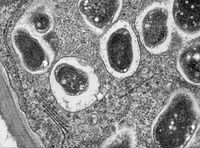
Effective enhancement of resistance to Phytophthora infestans by overexpression of miR172a and b in Solanum lycopersicum
Sign Up to like & getrecommendations! Published in 2017 at "Planta"
DOI: 10.1007/s00425-017-2773-x
Abstract: AbstractMain conclusionOverexpression of miR172a and b in tomato (Solanum lycopersicum) Zaofen No. 2 increased resistance toPhytophthora infestansinfection by suppressing of an AP2/ERF transcription factor. The miR172 family has been shown to participate in the growth… read more here.
Keywords: phytophthora infestans; resistance; erf transcription; ap2 erf ... See more keywords

Nonomuraea lycopersici sp. nov., isolated from the root of tomato plants (Solanum lycopersicum L.)
Sign Up to like & getrecommendations! Published in 2017 at "Antonie van Leeuwenhoek"
DOI: 10.1007/s10482-017-1012-6
Abstract: Two novel bacterial strains were isolated from the roots of tomato plants (Solanum lycopersicum L.) from Dengfeng, Henan Province, China. Phylogenetic analysis of 16S rRNA gene sequences showed that the isolates NEAU-DE8(1)T and NEAU-HE1(2) are… read more here.
Keywords: nonomuraea lycopersici; lycopersici nov; tomato plants; plants solanum ... See more keywords

Identification of salt-stress responsive microRNAs from Solanum lycopersicum and Solanum pimpinellifolium
Sign Up to like & getrecommendations! Published in 2017 at "Plant Growth Regulation"
DOI: 10.1007/s10725-017-0289-9
Abstract: MicroRNAs (miRNAs) are endogenous non-coding small RNAs, which play versatile roles in plant growth and development as well as stress response. Soil salinity is a major environmental limit for crop production. To identify conserved and… read more here.
Keywords: solanum lycopersicum; solanum; pimpinellifolium; salt stress ... See more keywords

Isolation and molecular characterization of MYB60 in Solanum lycopersicum.
Sign Up to like & getrecommendations! Published in 2021 at "Molecular biology reports"
DOI: 10.1007/s11033-021-06168-5
Abstract: Stomatal closure is a common adaptation response of plants to the onset of drought condition and its regulation is controlled by transcription factors. MYB60, a transcription factor involved in the regulation of light-induced stomatal opening,… read more here.
Keywords: characterization myb60; molecular characterization; isolation molecular; myb60 ... See more keywords

Bacterial production and reconstitution in proteoliposomes of Solanum lycopersicum CAT2: a transporter of basic amino acids and organic cations
Sign Up to like & getrecommendations! Published in 2017 at "Plant Molecular Biology"
DOI: 10.1007/s11103-017-0632-6
Abstract: AbstractKey messageThe vacuolar SlCAT2 was cloned, over-produced in E. coli and reconstituted in proteoliposomes. Arg, Ornithine and Lys were identified as substrates. Unexpectedly, also the organic cations Tetraethylammonium and Acetylcholine were transported indicating involvement of… read more here.
Keywords: acids organic; amino acids; organic cations; slcat2 ... See more keywords

Two promoter regions confer heat-induced activation of SlDREBA4 in Solanum lycopersicum.
Sign Up to like & getrecommendations! Published in 2020 at "Biochemical and biophysical research communications"
DOI: 10.1016/j.bbrc.2020.01.153
Abstract: Dehydration-responsive element binding (DREB) transcription factors activate the expression of downstream functional genes in combination with a dehydration-responsive element (DRE), and thereby improve the resistance of plants to abiotic stresses such as heat. However, the… read more here.
Keywords: heat induced; sldreba4; promoter; heat ... See more keywords

Supplementation with plant growth promoting rhizobacteria (PGPR) alleviates cadmium toxicity in Solanum lycopersicum by modulating the expression of secondary metabolites.
Sign Up to like & getrecommendations! Published in 2019 at "Chemosphere"
DOI: 10.1016/j.chemosphere.2019.05.072
Abstract: The current study evaluated the synergistic role of Plant growth promoting rhizobacteria (PGPR), Pseudomonas aeruginosa and Burkholderia gladioli on different physiological, biochemical and molecular activities of 10-days old Solanum lycopersicum seedlings under Cd stress. Cd… read more here.
Keywords: promoting rhizobacteria; plant growth; growth promoting; toxicity ... See more keywords

New disease caused by Neoscytalidium dimidiatum devastates tomatoes (Solanum lycopersicum) in Turkey
Sign Up to like & getrecommendations! Published in 2019 at "Crop Protection"
DOI: 10.1016/j.cropro.2018.12.004
Abstract: Abstract A novel disease of tomato (Solanum lycopersicum L.) was observed in the Southeast Anatolia Region of Turkey. Symptoms were blight of all aerial parts of the plant, including stems, branches, leaves, petioles, flowers and… read more here.
Keywords: solanum lycopersicum; neoscytalidium dimidiatum; dimidiatum; new disease ... See more keywords

In vitro gastrointestinal digestion and colonic fermentation of tomato (Solanum lycopersicum L.) and husk tomato (Physalis ixocarpa Brot.): Phenolic compounds released and bioconverted by gut microbiota.
Sign Up to like & getrecommendations! Published in 2021 at "Food chemistry"
DOI: 10.1016/j.foodchem.2021.130051
Abstract: Two of the most important Mexican plant-foods are tomato (Solanum lycopersicum L.) and husk tomato (Physalis ixocarpa Brot.). In this study three objectives were followed: i) to evaluate the bioaccessible phenolic compounds (PC) in T… read more here.
Keywords: fermentation; digestion; tomato; tomato solanum ... See more keywords

Glyphosate-dependent effects on photosynthesis of Solanum lycopersicum L.-An ecophysiological, ultrastructural and molecular approach.
Sign Up to like & getrecommendations! Published in 2020 at "Journal of hazardous materials"
DOI: 10.1016/j.jhazmat.2020.122871
Abstract: This study aimed to assess the toxicity of glyphosate (GLY; 0, 10, 20 and 30 mg kg-1) in Solanum lycopersicum L., particularly focusing on the photosynthetic metabolism. By combining ecophysiological, ultrastructural, biochemical and molecular tools, the results… read more here.
Keywords: glyphosate dependent; dependent effects; ecophysiological ultrastructural; effects photosynthesis ... See more keywords

Genome-wide association study and marker development for bacterial wilt resistance in tomato (Solanum lycopersicum L.)
Sign Up to like & getrecommendations! Published in 2021 at "Scientia Horticulturae"
DOI: 10.1016/j.scienta.2021.110418
Abstract: Abstract Bacterial wilt (BW), caused by the soil-borne Ralstonia solanacearum, is a major disease in cultivated tomato (Solanum lycopersicum L.). Host resistance provides an environment-friendly and cost-effective strategy to control this disease. To investigate quantitative… read more here.
Keywords: solanum lycopersicum; resistance; bacterial wilt; genome wide ... See more keywords